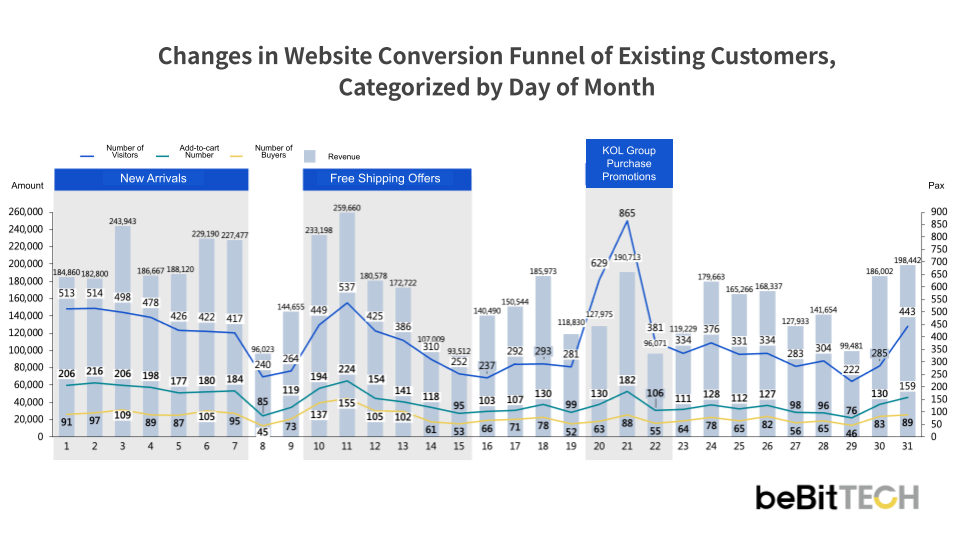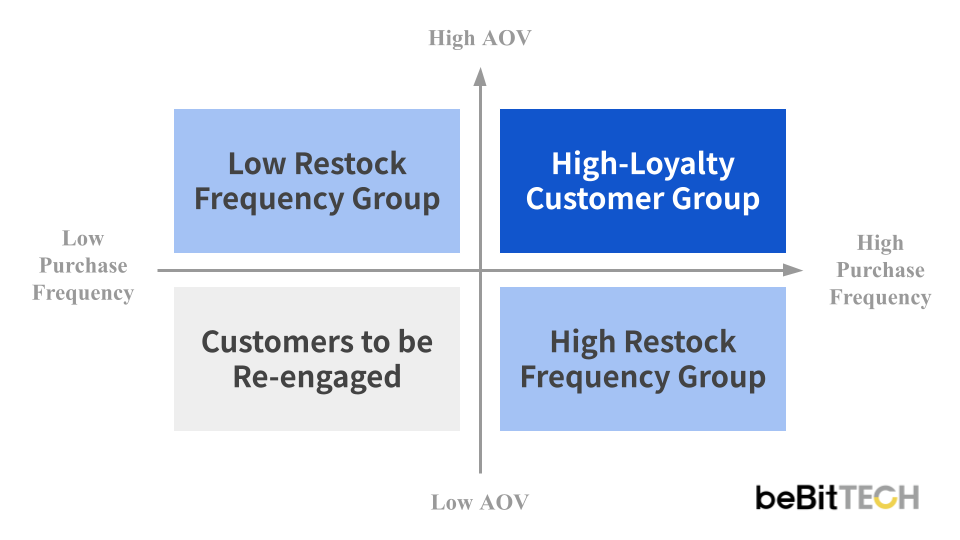Building on the previous article, to more effectively analyze GMV revenue and identify growth drivers, we need to break down both first-time and existing customers in detail. This approach helps uncover performance growth factors that might be overlooked in the broader metrics. By examining these segments separately, we can gain deeper insights into the specific elements contributing to overall revenue growth.
As mentioned in the previous article, besides first-time buyers, the ability of returning customers to continuously revisit and make repeat purchases signifies the deepening relationship between the brand and its loyal customers over time. While the average order value (AOV) may vary with different promotional periods, the longer a customer remains a member, the higher their average annual contribution tends to be. Mature e-commerce businesses typically evaluate revenue from existing customers using the following key metrics.

- Number of Returning Customers: The number of customers who have previously made a purchase and revisited the site within the month
- Add-to-Cart Rate: The number of returning customers who added items to their cart during that month / The total number of returning customers in that month
- Cart Conversion Rate: The number of returning customers who made a purchase during that month / The number of returning customers who added items to their cart in that month
- Average Order Value (AOV): The average amount spent per transaction by returning customers during that month
E-commerce Brands - Strategy for Managing Existing Customers: Balancing Growth and Efficiency
When it comes to managing existing customers, there are two key aspects that require proactive consideration:
- How to generate commercially valuable traffic from existing customers
- How to effectively retain the revenue from this traffic
Although it is still possible to generate substantial traffic from existing customers through the delivery of mass messages, it will still be a challenge to effectively recommend products to these customers upon their visit to the site or store without setting specific goals. Conversely, excessive restriction on incoming traffic might increase conversion rates, but it will be difficult to make a significant impact on revenue.
Evaluating the Effectiveness of Traffic
Based on the point number one, it is recommended to regularly assess the number of returning customers, add-to-cart rate, and cart conversion rate over a given period. Compare these metrics across different promotional periods to understand the relationship between various campaign types and site traffic, as well as the purchasing intent of visitors on site.

As shown in the chart, during the periods of new product launches and free shipping promotions, user visits were high, and both add-to-cart and checkout intentions were strong. However, during the KOL group-purchase campaign, although it generated a large amount of traffic, the proportion of purchases did not correspondingly increase. By making such comparisons, you can adopt a more comprehensive perspective, beyond just CPC, to evaluate the effectiveness of managing existing customers.
How to Effectively Retain Traffic
Regarding the second point, similar to converting new visitors at the time of registration, it's easy to miss opportunities with existing customers if their purchasing intent is not immediately captured, despite their relatively strong relationship with the brand. Therefore, when running campaigns to attract returning customers, it is generally recommended to regularly communicate with users who have browsed or added to cart but did not convert during the pre-, mid-, and post-campaign periods. This ensures that the incoming traffic can steadily convert.

For example, with beBit TECH's SaaS product - the OmniSegment CDP, our consultants typically advise clients to create behavioral scripts based on the respective customer behaviors in respective marketing funnels, such as 'browsing without adding to cart' and 'adding to cart without completing purchase'. Clients may even extend this method to segment different products, enhancing the effectiveness of re-engagement efforts.
Optimizing Traffic Efficiency: Average Order Value (AOV)
Simply looking at the average order value (AOV) is not sufficient to determine customer loyalty. It is essential to segment customers based on their purchase frequency. Customers with high-frequency purchases often place orders as soon as they notice their stock is running low, resulting in a lower AOV per purchase. This is a normal phenomenon, and their loyalty should be evaluated based on their total annual contribution. Conversely, low-frequency buyers might have a habit of stocking up, leading to a higher AOV per purchase to meet their overall needs.

By creating a matrix based on average order value (AOV) and purchase frequency, brands can clearly observe the consumption patterns of various customer segments. Customers with high annual purchase frequency and high order value are obviously the most desirable loyal customers for any brand. However, those with low purchase frequency but high order value, as well as those with high purchase frequency but low order value, represent two distinct types of consumer behavior. Despite their differences, both groups are valuable to the brand's overall performance. For customers with both low purchase frequency and low order value, it's crucial to develop strategies to shift them into one of the active quadrants. Common approaches include subscription models or offering discounts on bulk purchases.
Conclusion
For brands, engaging in deeper connections with loyal customers will greatly influence their decision to make continuous revisits and purchases. It is crucial to specifically analyze key performance metrics such as returning customer rate, add-to-cart rate, cart conversion rate, and average order value (AOV). Managing existing customers requires balancing 'source expansion' and 'waste reduction', that is, generating commercially valuable traffic and effectively retaining revenue. Evaluating traffic effectiveness includes a comprehensive assessment of consumer intentions across different campaigns and traffic sources. It is recommended to regularly engage and communicate with users who browsed or added items to their cart without making purchase, especially during the pre-, mid-, and post-campaign periods, to ensure steady conversion of traffic. Optimizing traffic efficiency involves not only considering AOV, but also purchase frequency. By creating a matrix according to the different types of users, consumption patterns can be better observed, allowing for more personalized solutions.







